Project Governance Model and Application: Melbourne Metro Rail Project
VerifiedAdded on 2022/11/19
|17
|4247
|109
Report
AI Summary
This report delves into the critical aspects of project governance, emphasizing the elements that contribute to project success. It begins with an introduction to project governance, highlighting its significance in organizational business and capital investment. The report identifies six key elements for project success: smart people, smart planning, open communication, careful risk management, and project closure, along with project scope, realistic schedule, communication plan, risk management plan, roles and responsibilities, and project tracking. A project governance model is then presented, encompassing structure, people, and information pillars. The report applies this model to the Melbourne Metro Rail project, outlining its benefits, including commuter, sustainable population and jobs growth, economic, and social advantages. The Melbourne Metro Rail project, a major metropolitan rail infrastructure project, serves as a case study to demonstrate the practical application of the project governance model. The report concludes by summarizing the key findings and emphasizing the importance of effective project governance for achieving project objectives.
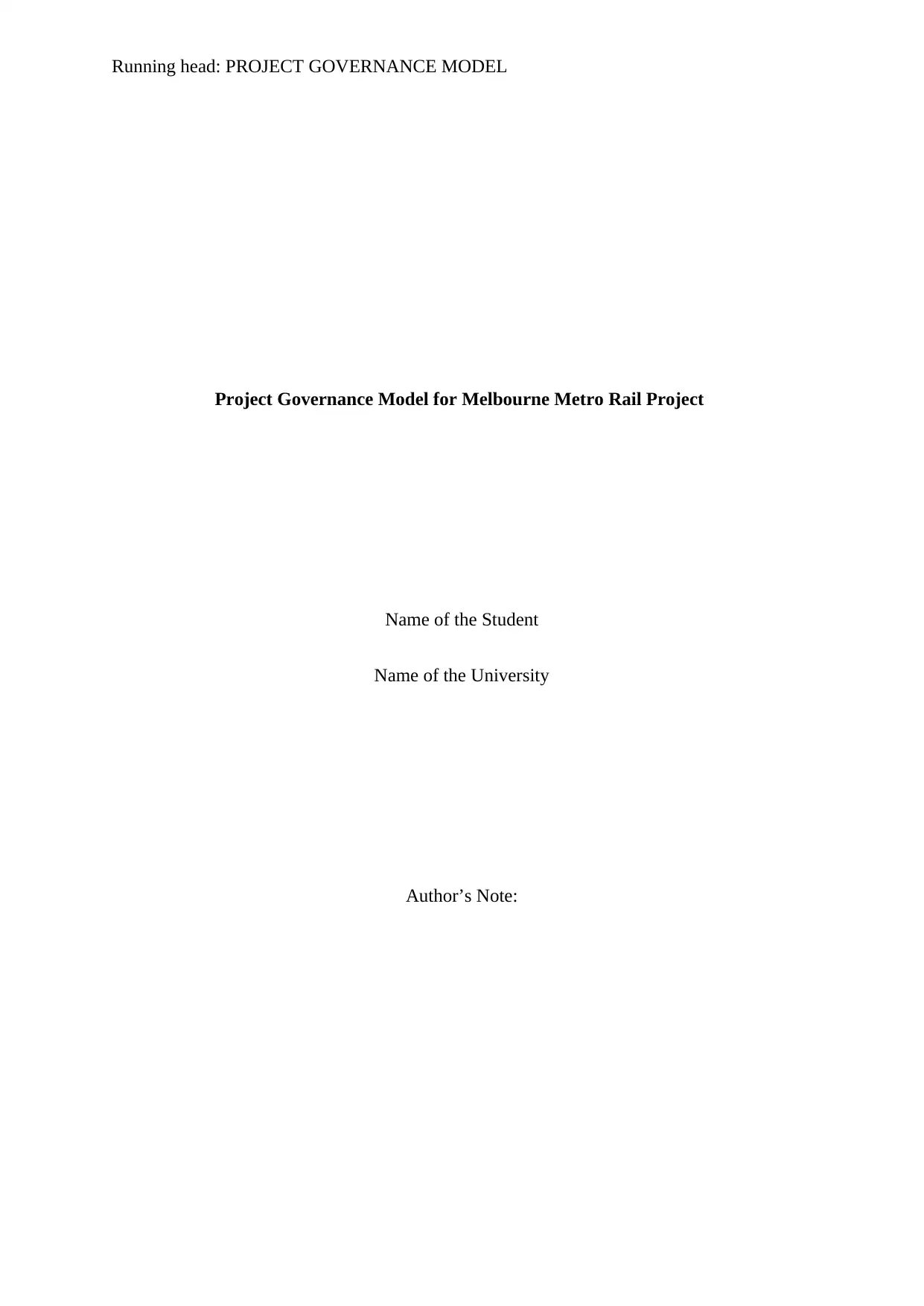
Running head: PROJECT GOVERNANCE MODEL
Project Governance Model for Melbourne Metro Rail Project
Name of the Student
Name of the University
Author’s Note:
Project Governance Model for Melbourne Metro Rail Project
Name of the Student
Name of the University
Author’s Note:
Paraphrase This Document
Need a fresh take? Get an instant paraphrase of this document with our AI Paraphraser
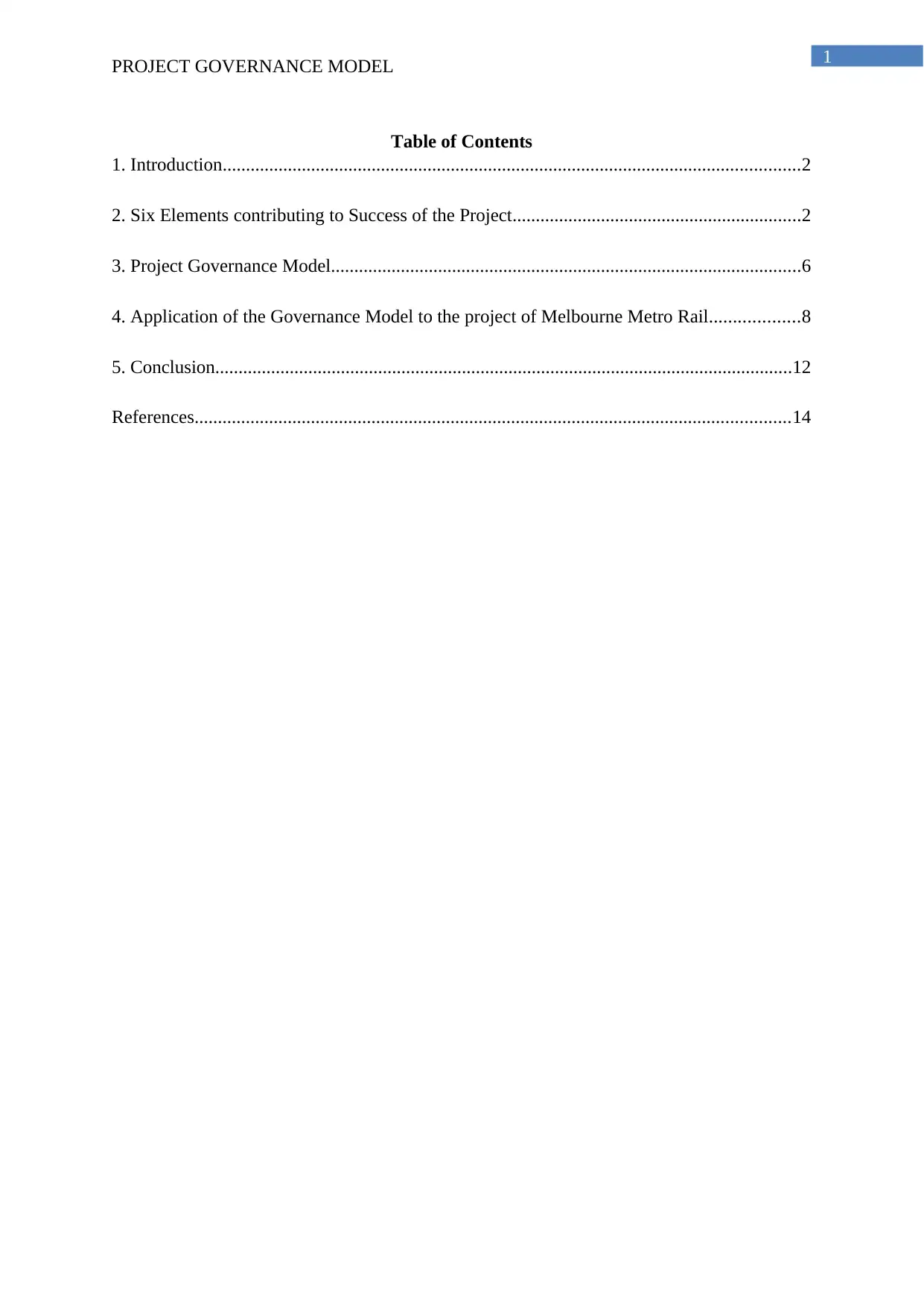
1
PROJECT GOVERNANCE MODEL
Table of Contents
1. Introduction............................................................................................................................2
2. Six Elements contributing to Success of the Project..............................................................2
3. Project Governance Model.....................................................................................................6
4. Application of the Governance Model to the project of Melbourne Metro Rail...................8
5. Conclusion............................................................................................................................12
References................................................................................................................................14
PROJECT GOVERNANCE MODEL
Table of Contents
1. Introduction............................................................................................................................2
2. Six Elements contributing to Success of the Project..............................................................2
3. Project Governance Model.....................................................................................................6
4. Application of the Governance Model to the project of Melbourne Metro Rail...................8
5. Conclusion............................................................................................................................12
References................................................................................................................................14
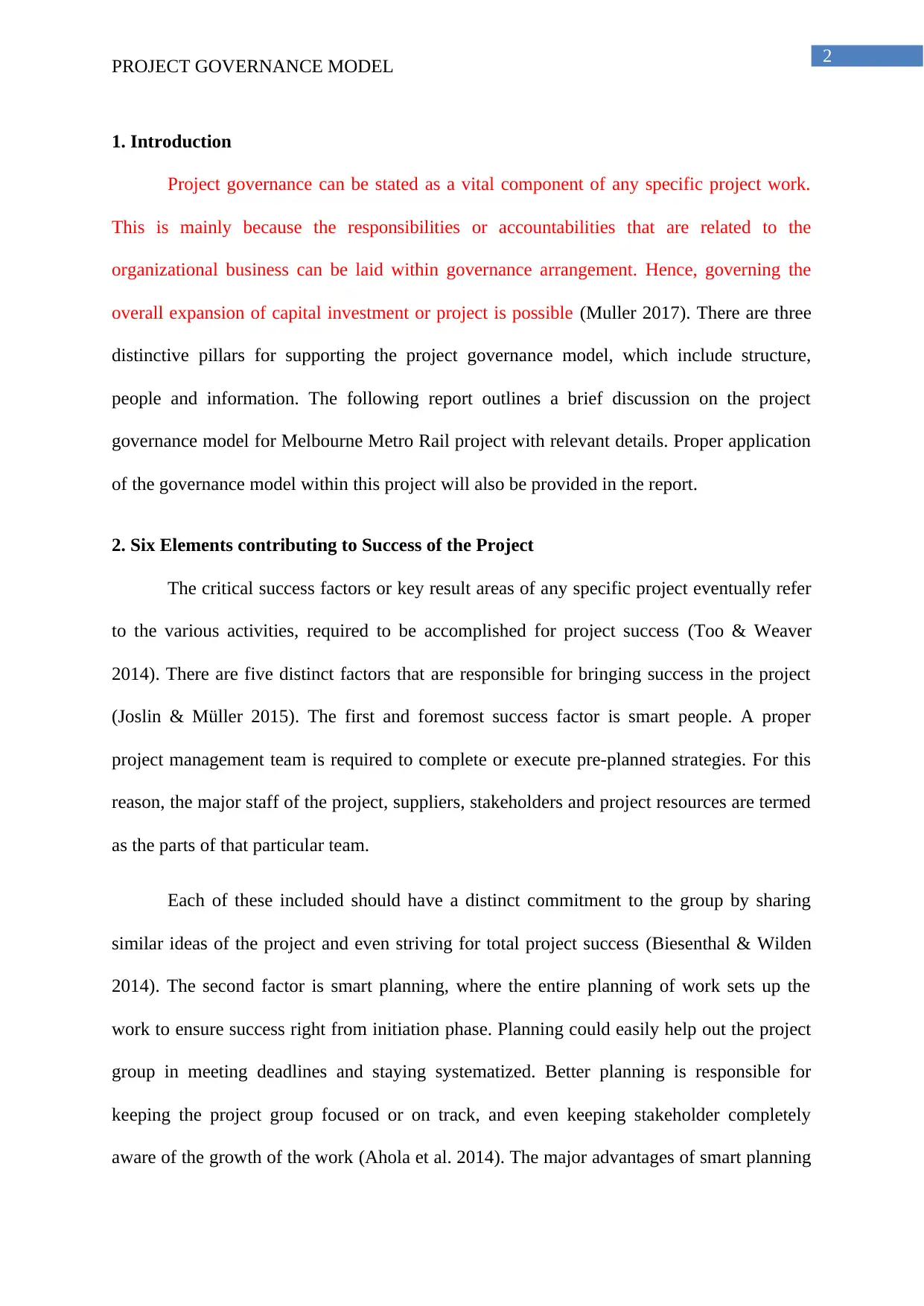
2
PROJECT GOVERNANCE MODEL
1. Introduction
Project governance can be stated as a vital component of any specific project work.
This is mainly because the responsibilities or accountabilities that are related to the
organizational business can be laid within governance arrangement. Hence, governing the
overall expansion of capital investment or project is possible (Muller 2017). There are three
distinctive pillars for supporting the project governance model, which include structure,
people and information. The following report outlines a brief discussion on the project
governance model for Melbourne Metro Rail project with relevant details. Proper application
of the governance model within this project will also be provided in the report.
2. Six Elements contributing to Success of the Project
The critical success factors or key result areas of any specific project eventually refer
to the various activities, required to be accomplished for project success (Too & Weaver
2014). There are five distinct factors that are responsible for bringing success in the project
(Joslin & Müller 2015). The first and foremost success factor is smart people. A proper
project management team is required to complete or execute pre-planned strategies. For this
reason, the major staff of the project, suppliers, stakeholders and project resources are termed
as the parts of that particular team.
Each of these included should have a distinct commitment to the group by sharing
similar ideas of the project and even striving for total project success (Biesenthal & Wilden
2014). The second factor is smart planning, where the entire planning of work sets up the
work to ensure success right from initiation phase. Planning could easily help out the project
group in meeting deadlines and staying systematized. Better planning is responsible for
keeping the project group focused or on track, and even keeping stakeholder completely
aware of the growth of the work (Ahola et al. 2014). The major advantages of smart planning
PROJECT GOVERNANCE MODEL
1. Introduction
Project governance can be stated as a vital component of any specific project work.
This is mainly because the responsibilities or accountabilities that are related to the
organizational business can be laid within governance arrangement. Hence, governing the
overall expansion of capital investment or project is possible (Muller 2017). There are three
distinctive pillars for supporting the project governance model, which include structure,
people and information. The following report outlines a brief discussion on the project
governance model for Melbourne Metro Rail project with relevant details. Proper application
of the governance model within this project will also be provided in the report.
2. Six Elements contributing to Success of the Project
The critical success factors or key result areas of any specific project eventually refer
to the various activities, required to be accomplished for project success (Too & Weaver
2014). There are five distinct factors that are responsible for bringing success in the project
(Joslin & Müller 2015). The first and foremost success factor is smart people. A proper
project management team is required to complete or execute pre-planned strategies. For this
reason, the major staff of the project, suppliers, stakeholders and project resources are termed
as the parts of that particular team.
Each of these included should have a distinct commitment to the group by sharing
similar ideas of the project and even striving for total project success (Biesenthal & Wilden
2014). The second factor is smart planning, where the entire planning of work sets up the
work to ensure success right from initiation phase. Planning could easily help out the project
group in meeting deadlines and staying systematized. Better planning is responsible for
keeping the project group focused or on track, and even keeping stakeholder completely
aware of the growth of the work (Ahola et al. 2014). The major advantages of smart planning
⊘ This is a preview!⊘
Do you want full access?
Subscribe today to unlock all pages.

Trusted by 1+ million students worldwide
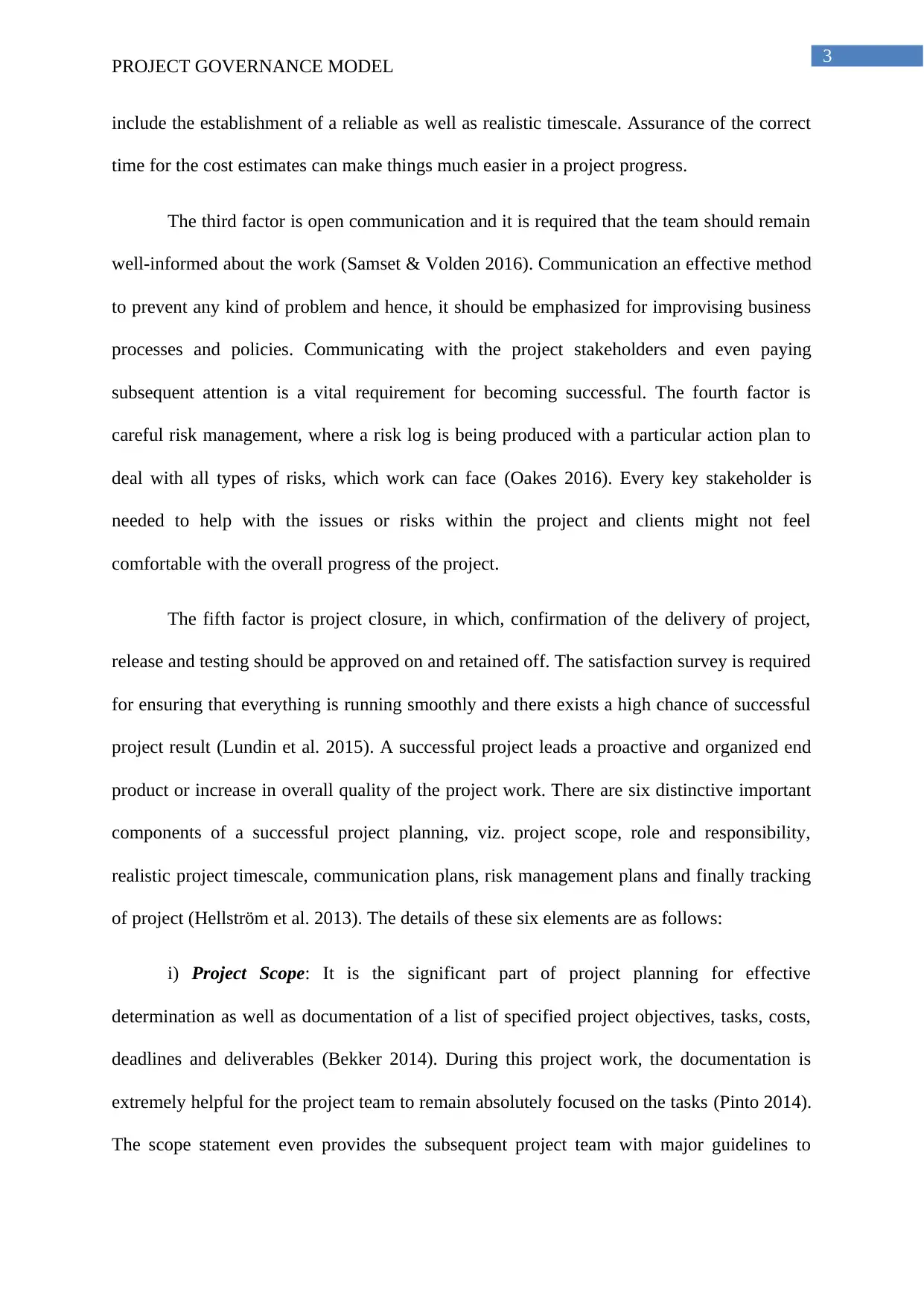
3
PROJECT GOVERNANCE MODEL
include the establishment of a reliable as well as realistic timescale. Assurance of the correct
time for the cost estimates can make things much easier in a project progress.
The third factor is open communication and it is required that the team should remain
well-informed about the work (Samset & Volden 2016). Communication an effective method
to prevent any kind of problem and hence, it should be emphasized for improvising business
processes and policies. Communicating with the project stakeholders and even paying
subsequent attention is a vital requirement for becoming successful. The fourth factor is
careful risk management, where a risk log is being produced with a particular action plan to
deal with all types of risks, which work can face (Oakes 2016). Every key stakeholder is
needed to help with the issues or risks within the project and clients might not feel
comfortable with the overall progress of the project.
The fifth factor is project closure, in which, confirmation of the delivery of project,
release and testing should be approved on and retained off. The satisfaction survey is required
for ensuring that everything is running smoothly and there exists a high chance of successful
project result (Lundin et al. 2015). A successful project leads a proactive and organized end
product or increase in overall quality of the project work. There are six distinctive important
components of a successful project planning, viz. project scope, role and responsibility,
realistic project timescale, communication plans, risk management plans and finally tracking
of project (Hellström et al. 2013). The details of these six elements are as follows:
i) Project Scope: It is the significant part of project planning for effective
determination as well as documentation of a list of specified project objectives, tasks, costs,
deadlines and deliverables (Bekker 2014). During this project work, the documentation is
extremely helpful for the project team to remain absolutely focused on the tasks (Pinto 2014).
The scope statement even provides the subsequent project team with major guidelines to
PROJECT GOVERNANCE MODEL
include the establishment of a reliable as well as realistic timescale. Assurance of the correct
time for the cost estimates can make things much easier in a project progress.
The third factor is open communication and it is required that the team should remain
well-informed about the work (Samset & Volden 2016). Communication an effective method
to prevent any kind of problem and hence, it should be emphasized for improvising business
processes and policies. Communicating with the project stakeholders and even paying
subsequent attention is a vital requirement for becoming successful. The fourth factor is
careful risk management, where a risk log is being produced with a particular action plan to
deal with all types of risks, which work can face (Oakes 2016). Every key stakeholder is
needed to help with the issues or risks within the project and clients might not feel
comfortable with the overall progress of the project.
The fifth factor is project closure, in which, confirmation of the delivery of project,
release and testing should be approved on and retained off. The satisfaction survey is required
for ensuring that everything is running smoothly and there exists a high chance of successful
project result (Lundin et al. 2015). A successful project leads a proactive and organized end
product or increase in overall quality of the project work. There are six distinctive important
components of a successful project planning, viz. project scope, role and responsibility,
realistic project timescale, communication plans, risk management plans and finally tracking
of project (Hellström et al. 2013). The details of these six elements are as follows:
i) Project Scope: It is the significant part of project planning for effective
determination as well as documentation of a list of specified project objectives, tasks, costs,
deadlines and deliverables (Bekker 2014). During this project work, the documentation is
extremely helpful for the project team to remain absolutely focused on the tasks (Pinto 2014).
The scope statement even provides the subsequent project team with major guidelines to
Paraphrase This Document
Need a fresh take? Get an instant paraphrase of this document with our AI Paraphraser
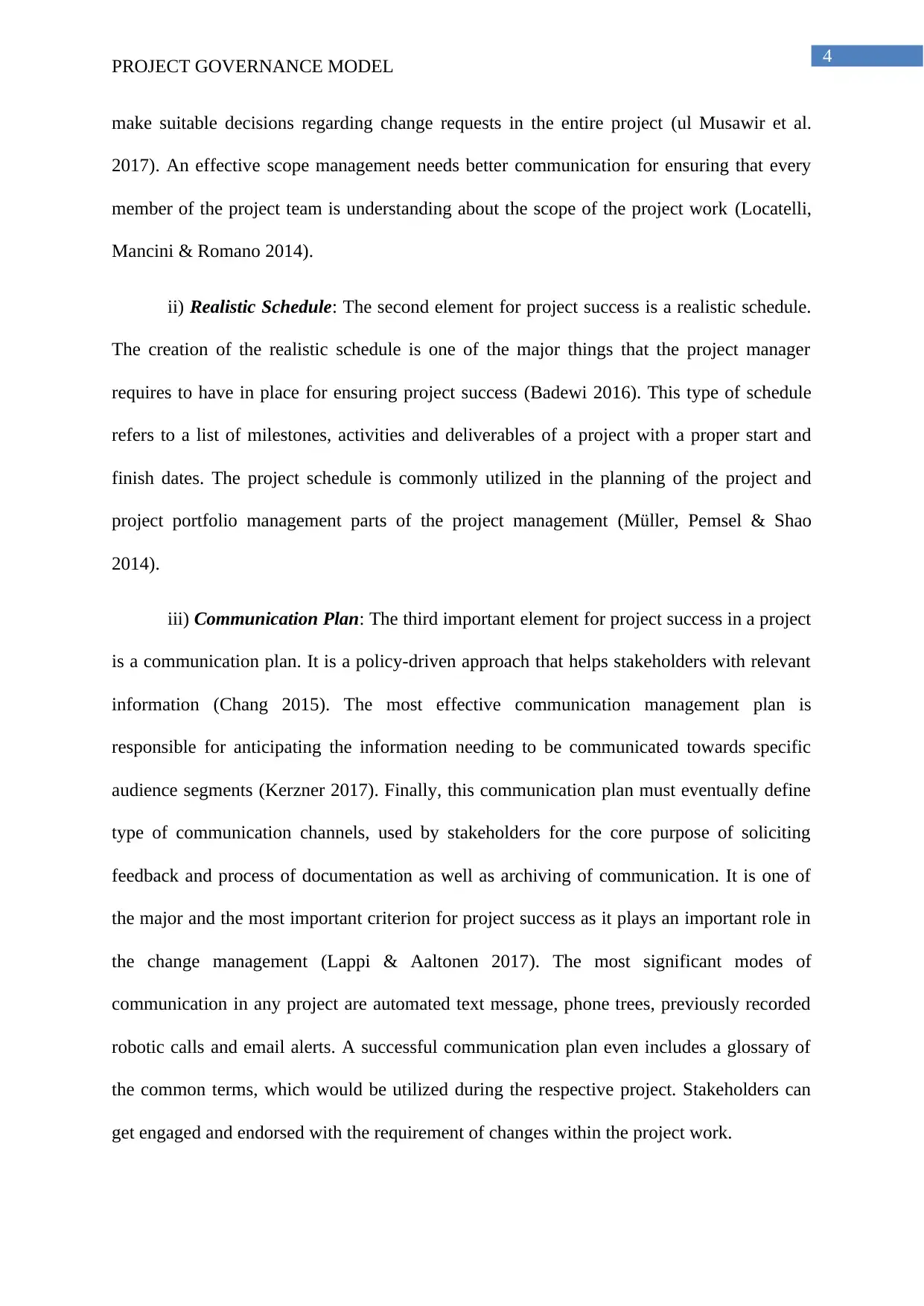
4
PROJECT GOVERNANCE MODEL
make suitable decisions regarding change requests in the entire project (ul Musawir et al.
2017). An effective scope management needs better communication for ensuring that every
member of the project team is understanding about the scope of the project work (Locatelli,
Mancini & Romano 2014).
ii) Realistic Schedule: The second element for project success is a realistic schedule.
The creation of the realistic schedule is one of the major things that the project manager
requires to have in place for ensuring project success (Badewi 2016). This type of schedule
refers to a list of milestones, activities and deliverables of a project with a proper start and
finish dates. The project schedule is commonly utilized in the planning of the project and
project portfolio management parts of the project management (Müller, Pemsel & Shao
2014).
iii) Communication Plan: The third important element for project success in a project
is a communication plan. It is a policy-driven approach that helps stakeholders with relevant
information (Chang 2015). The most effective communication management plan is
responsible for anticipating the information needing to be communicated towards specific
audience segments (Kerzner 2017). Finally, this communication plan must eventually define
type of communication channels, used by stakeholders for the core purpose of soliciting
feedback and process of documentation as well as archiving of communication. It is one of
the major and the most important criterion for project success as it plays an important role in
the change management (Lappi & Aaltonen 2017). The most significant modes of
communication in any project are automated text message, phone trees, previously recorded
robotic calls and email alerts. A successful communication plan even includes a glossary of
the common terms, which would be utilized during the respective project. Stakeholders can
get engaged and endorsed with the requirement of changes within the project work.
PROJECT GOVERNANCE MODEL
make suitable decisions regarding change requests in the entire project (ul Musawir et al.
2017). An effective scope management needs better communication for ensuring that every
member of the project team is understanding about the scope of the project work (Locatelli,
Mancini & Romano 2014).
ii) Realistic Schedule: The second element for project success is a realistic schedule.
The creation of the realistic schedule is one of the major things that the project manager
requires to have in place for ensuring project success (Badewi 2016). This type of schedule
refers to a list of milestones, activities and deliverables of a project with a proper start and
finish dates. The project schedule is commonly utilized in the planning of the project and
project portfolio management parts of the project management (Müller, Pemsel & Shao
2014).
iii) Communication Plan: The third important element for project success in a project
is a communication plan. It is a policy-driven approach that helps stakeholders with relevant
information (Chang 2015). The most effective communication management plan is
responsible for anticipating the information needing to be communicated towards specific
audience segments (Kerzner 2017). Finally, this communication plan must eventually define
type of communication channels, used by stakeholders for the core purpose of soliciting
feedback and process of documentation as well as archiving of communication. It is one of
the major and the most important criterion for project success as it plays an important role in
the change management (Lappi & Aaltonen 2017). The most significant modes of
communication in any project are automated text message, phone trees, previously recorded
robotic calls and email alerts. A successful communication plan even includes a glossary of
the common terms, which would be utilized during the respective project. Stakeholders can
get engaged and endorsed with the requirement of changes within the project work.
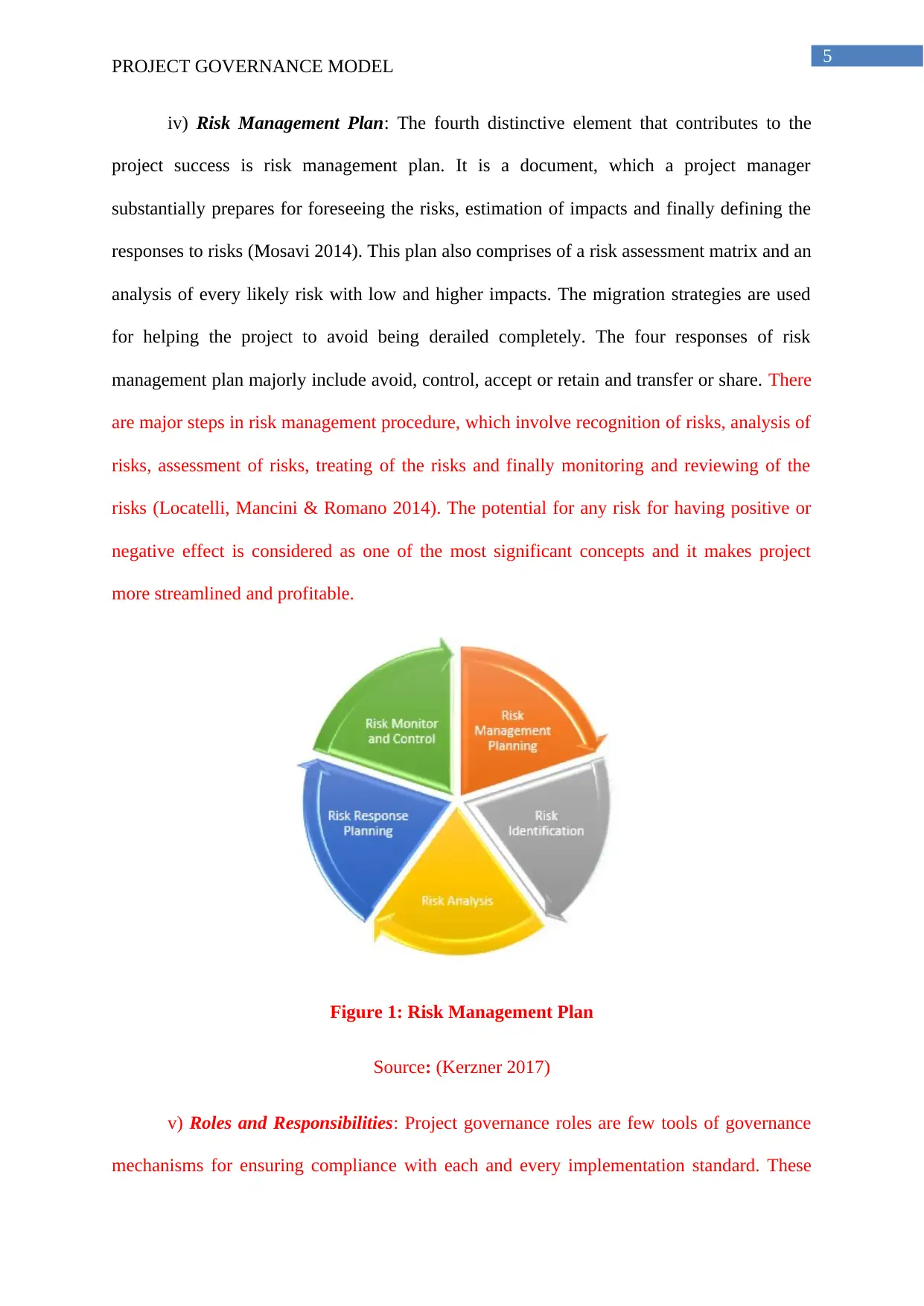
5
PROJECT GOVERNANCE MODEL
iv) Risk Management Plan: The fourth distinctive element that contributes to the
project success is risk management plan. It is a document, which a project manager
substantially prepares for foreseeing the risks, estimation of impacts and finally defining the
responses to risks (Mosavi 2014). This plan also comprises of a risk assessment matrix and an
analysis of every likely risk with low and higher impacts. The migration strategies are used
for helping the project to avoid being derailed completely. The four responses of risk
management plan majorly include avoid, control, accept or retain and transfer or share. There
are major steps in risk management procedure, which involve recognition of risks, analysis of
risks, assessment of risks, treating of the risks and finally monitoring and reviewing of the
risks (Locatelli, Mancini & Romano 2014). The potential for any risk for having positive or
negative effect is considered as one of the most significant concepts and it makes project
more streamlined and profitable.
Figure 1: Risk Management Plan
Source: (Kerzner 2017)
v) Roles and Responsibilities: Project governance roles are few tools of governance
mechanisms for ensuring compliance with each and every implementation standard. These
PROJECT GOVERNANCE MODEL
iv) Risk Management Plan: The fourth distinctive element that contributes to the
project success is risk management plan. It is a document, which a project manager
substantially prepares for foreseeing the risks, estimation of impacts and finally defining the
responses to risks (Mosavi 2014). This plan also comprises of a risk assessment matrix and an
analysis of every likely risk with low and higher impacts. The migration strategies are used
for helping the project to avoid being derailed completely. The four responses of risk
management plan majorly include avoid, control, accept or retain and transfer or share. There
are major steps in risk management procedure, which involve recognition of risks, analysis of
risks, assessment of risks, treating of the risks and finally monitoring and reviewing of the
risks (Locatelli, Mancini & Romano 2014). The potential for any risk for having positive or
negative effect is considered as one of the most significant concepts and it makes project
more streamlined and profitable.
Figure 1: Risk Management Plan
Source: (Kerzner 2017)
v) Roles and Responsibilities: Project governance roles are few tools of governance
mechanisms for ensuring compliance with each and every implementation standard. These
⊘ This is a preview!⊘
Do you want full access?
Subscribe today to unlock all pages.

Trusted by 1+ million students worldwide
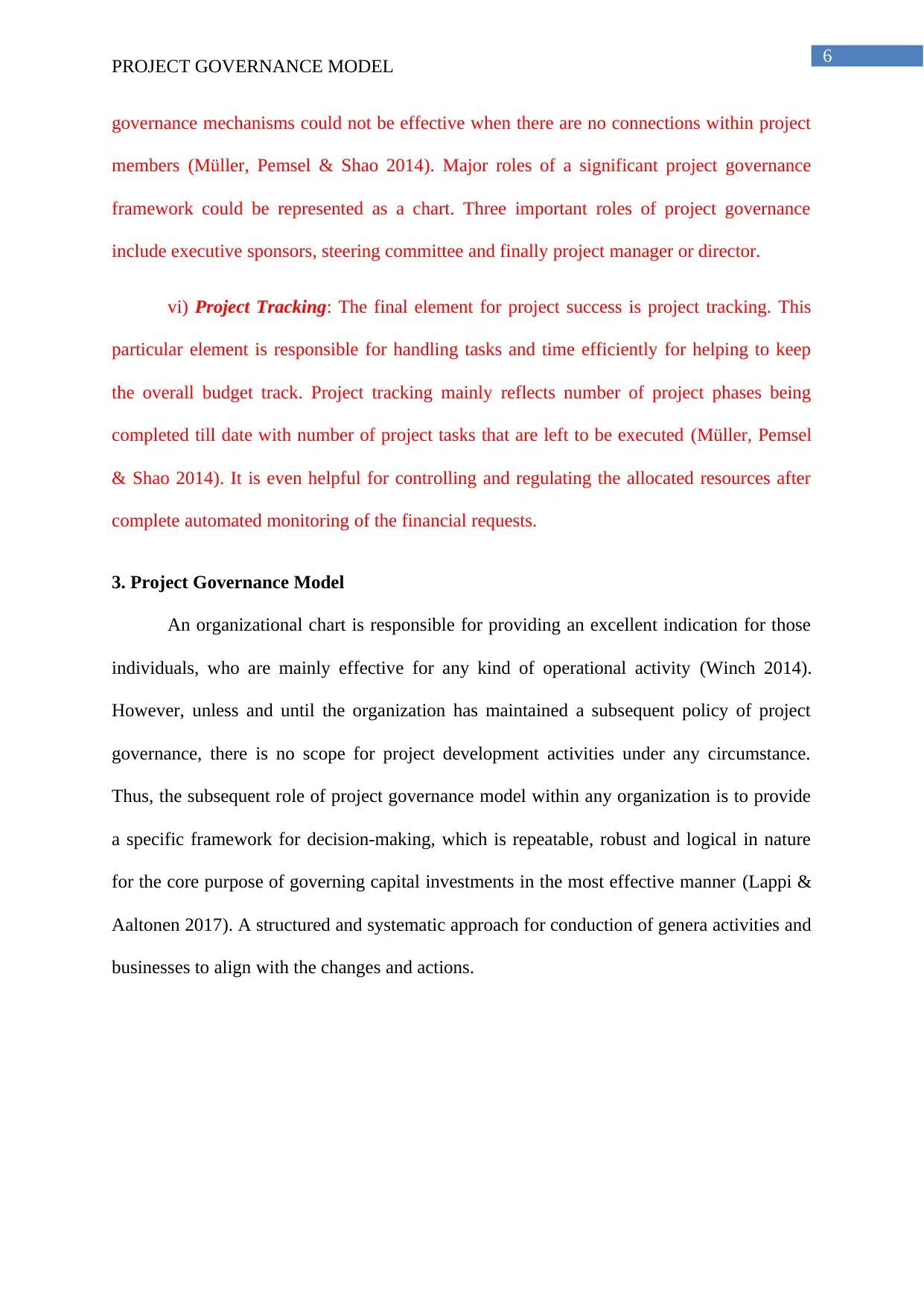
6
PROJECT GOVERNANCE MODEL
governance mechanisms could not be effective when there are no connections within project
members (Müller, Pemsel & Shao 2014). Major roles of a significant project governance
framework could be represented as a chart. Three important roles of project governance
include executive sponsors, steering committee and finally project manager or director.
vi) Project Tracking: The final element for project success is project tracking. This
particular element is responsible for handling tasks and time efficiently for helping to keep
the overall budget track. Project tracking mainly reflects number of project phases being
completed till date with number of project tasks that are left to be executed (Müller, Pemsel
& Shao 2014). It is even helpful for controlling and regulating the allocated resources after
complete automated monitoring of the financial requests.
3. Project Governance Model
An organizational chart is responsible for providing an excellent indication for those
individuals, who are mainly effective for any kind of operational activity (Winch 2014).
However, unless and until the organization has maintained a subsequent policy of project
governance, there is no scope for project development activities under any circumstance.
Thus, the subsequent role of project governance model within any organization is to provide
a specific framework for decision-making, which is repeatable, robust and logical in nature
for the core purpose of governing capital investments in the most effective manner (Lappi &
Aaltonen 2017). A structured and systematic approach for conduction of genera activities and
businesses to align with the changes and actions.
PROJECT GOVERNANCE MODEL
governance mechanisms could not be effective when there are no connections within project
members (Müller, Pemsel & Shao 2014). Major roles of a significant project governance
framework could be represented as a chart. Three important roles of project governance
include executive sponsors, steering committee and finally project manager or director.
vi) Project Tracking: The final element for project success is project tracking. This
particular element is responsible for handling tasks and time efficiently for helping to keep
the overall budget track. Project tracking mainly reflects number of project phases being
completed till date with number of project tasks that are left to be executed (Müller, Pemsel
& Shao 2014). It is even helpful for controlling and regulating the allocated resources after
complete automated monitoring of the financial requests.
3. Project Governance Model
An organizational chart is responsible for providing an excellent indication for those
individuals, who are mainly effective for any kind of operational activity (Winch 2014).
However, unless and until the organization has maintained a subsequent policy of project
governance, there is no scope for project development activities under any circumstance.
Thus, the subsequent role of project governance model within any organization is to provide
a specific framework for decision-making, which is repeatable, robust and logical in nature
for the core purpose of governing capital investments in the most effective manner (Lappi &
Aaltonen 2017). A structured and systematic approach for conduction of genera activities and
businesses to align with the changes and actions.
Paraphrase This Document
Need a fresh take? Get an instant paraphrase of this document with our AI Paraphraser
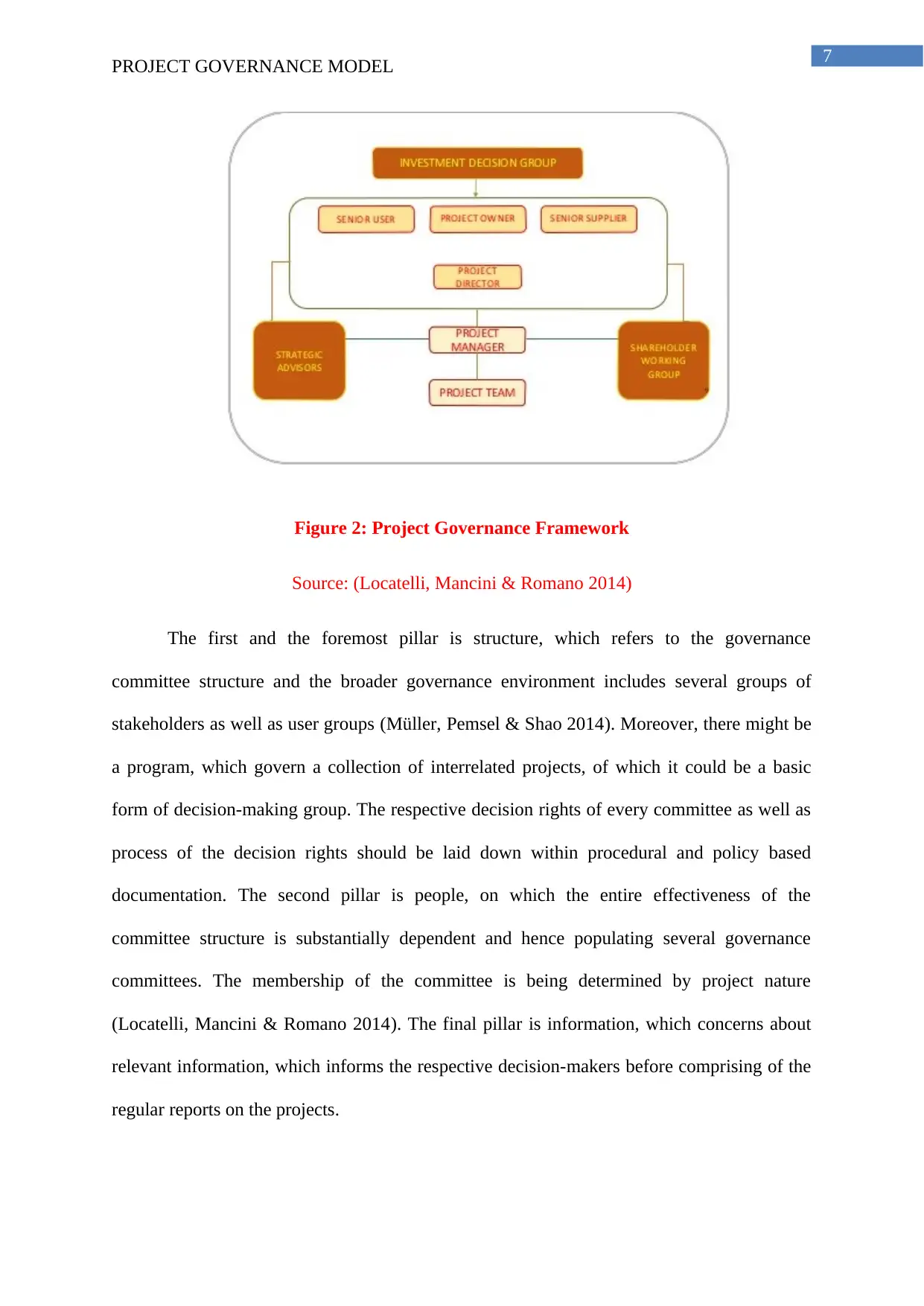
7
PROJECT GOVERNANCE MODEL
Figure 2: Project Governance Framework
Source: (Locatelli, Mancini & Romano 2014)
The first and the foremost pillar is structure, which refers to the governance
committee structure and the broader governance environment includes several groups of
stakeholders as well as user groups (Müller, Pemsel & Shao 2014). Moreover, there might be
a program, which govern a collection of interrelated projects, of which it could be a basic
form of decision-making group. The respective decision rights of every committee as well as
process of the decision rights should be laid down within procedural and policy based
documentation. The second pillar is people, on which the entire effectiveness of the
committee structure is substantially dependent and hence populating several governance
committees. The membership of the committee is being determined by project nature
(Locatelli, Mancini & Romano 2014). The final pillar is information, which concerns about
relevant information, which informs the respective decision-makers before comprising of the
regular reports on the projects.
PROJECT GOVERNANCE MODEL
Figure 2: Project Governance Framework
Source: (Locatelli, Mancini & Romano 2014)
The first and the foremost pillar is structure, which refers to the governance
committee structure and the broader governance environment includes several groups of
stakeholders as well as user groups (Müller, Pemsel & Shao 2014). Moreover, there might be
a program, which govern a collection of interrelated projects, of which it could be a basic
form of decision-making group. The respective decision rights of every committee as well as
process of the decision rights should be laid down within procedural and policy based
documentation. The second pillar is people, on which the entire effectiveness of the
committee structure is substantially dependent and hence populating several governance
committees. The membership of the committee is being determined by project nature
(Locatelli, Mancini & Romano 2014). The final pillar is information, which concerns about
relevant information, which informs the respective decision-makers before comprising of the
regular reports on the projects.
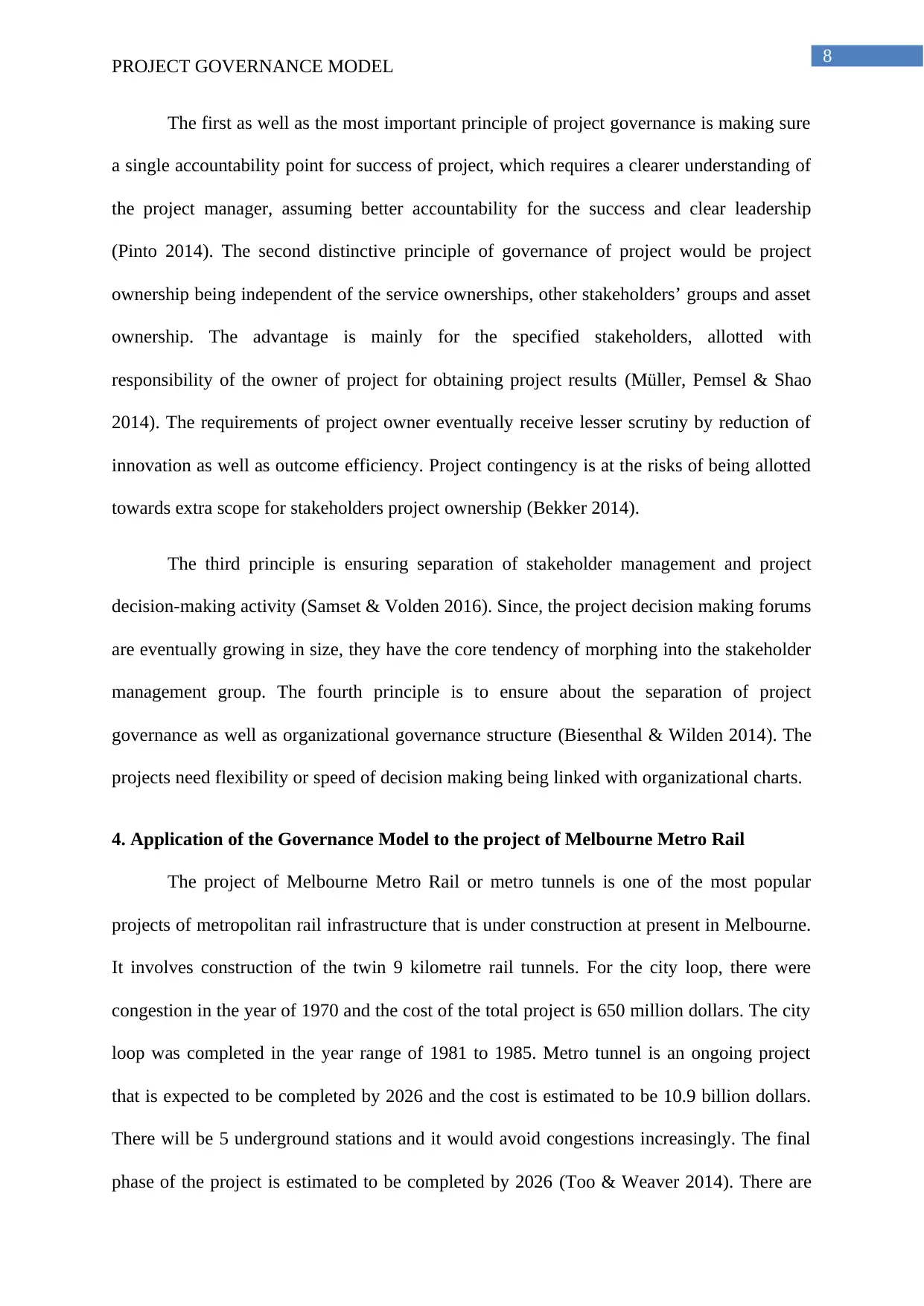
8
PROJECT GOVERNANCE MODEL
The first as well as the most important principle of project governance is making sure
a single accountability point for success of project, which requires a clearer understanding of
the project manager, assuming better accountability for the success and clear leadership
(Pinto 2014). The second distinctive principle of governance of project would be project
ownership being independent of the service ownerships, other stakeholders’ groups and asset
ownership. The advantage is mainly for the specified stakeholders, allotted with
responsibility of the owner of project for obtaining project results (Müller, Pemsel & Shao
2014). The requirements of project owner eventually receive lesser scrutiny by reduction of
innovation as well as outcome efficiency. Project contingency is at the risks of being allotted
towards extra scope for stakeholders project ownership (Bekker 2014).
The third principle is ensuring separation of stakeholder management and project
decision-making activity (Samset & Volden 2016). Since, the project decision making forums
are eventually growing in size, they have the core tendency of morphing into the stakeholder
management group. The fourth principle is to ensure about the separation of project
governance as well as organizational governance structure (Biesenthal & Wilden 2014). The
projects need flexibility or speed of decision making being linked with organizational charts.
4. Application of the Governance Model to the project of Melbourne Metro Rail
The project of Melbourne Metro Rail or metro tunnels is one of the most popular
projects of metropolitan rail infrastructure that is under construction at present in Melbourne.
It involves construction of the twin 9 kilometre rail tunnels. For the city loop, there were
congestion in the year of 1970 and the cost of the total project is 650 million dollars. The city
loop was completed in the year range of 1981 to 1985. Metro tunnel is an ongoing project
that is expected to be completed by 2026 and the cost is estimated to be 10.9 billion dollars.
There will be 5 underground stations and it would avoid congestions increasingly. The final
phase of the project is estimated to be completed by 2026 (Too & Weaver 2014). There are
PROJECT GOVERNANCE MODEL
The first as well as the most important principle of project governance is making sure
a single accountability point for success of project, which requires a clearer understanding of
the project manager, assuming better accountability for the success and clear leadership
(Pinto 2014). The second distinctive principle of governance of project would be project
ownership being independent of the service ownerships, other stakeholders’ groups and asset
ownership. The advantage is mainly for the specified stakeholders, allotted with
responsibility of the owner of project for obtaining project results (Müller, Pemsel & Shao
2014). The requirements of project owner eventually receive lesser scrutiny by reduction of
innovation as well as outcome efficiency. Project contingency is at the risks of being allotted
towards extra scope for stakeholders project ownership (Bekker 2014).
The third principle is ensuring separation of stakeholder management and project
decision-making activity (Samset & Volden 2016). Since, the project decision making forums
are eventually growing in size, they have the core tendency of morphing into the stakeholder
management group. The fourth principle is to ensure about the separation of project
governance as well as organizational governance structure (Biesenthal & Wilden 2014). The
projects need flexibility or speed of decision making being linked with organizational charts.
4. Application of the Governance Model to the project of Melbourne Metro Rail
The project of Melbourne Metro Rail or metro tunnels is one of the most popular
projects of metropolitan rail infrastructure that is under construction at present in Melbourne.
It involves construction of the twin 9 kilometre rail tunnels. For the city loop, there were
congestion in the year of 1970 and the cost of the total project is 650 million dollars. The city
loop was completed in the year range of 1981 to 1985. Metro tunnel is an ongoing project
that is expected to be completed by 2026 and the cost is estimated to be 10.9 billion dollars.
There will be 5 underground stations and it would avoid congestions increasingly. The final
phase of the project is estimated to be completed by 2026 (Too & Weaver 2014). There are
⊘ This is a preview!⊘
Do you want full access?
Subscribe today to unlock all pages.

Trusted by 1+ million students worldwide
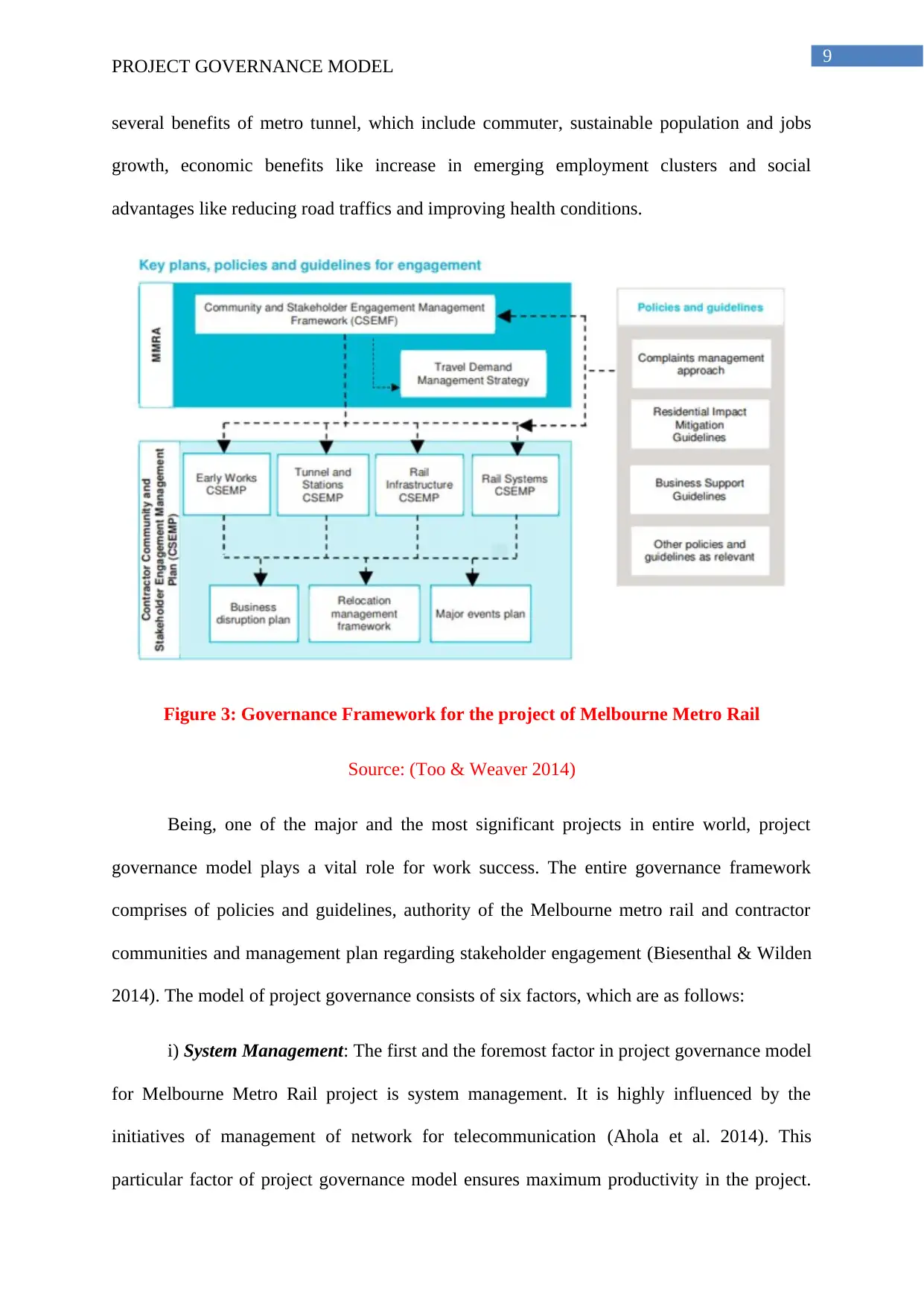
9
PROJECT GOVERNANCE MODEL
several benefits of metro tunnel, which include commuter, sustainable population and jobs
growth, economic benefits like increase in emerging employment clusters and social
advantages like reducing road traffics and improving health conditions.
Figure 3: Governance Framework for the project of Melbourne Metro Rail
Source: (Too & Weaver 2014)
Being, one of the major and the most significant projects in entire world, project
governance model plays a vital role for work success. The entire governance framework
comprises of policies and guidelines, authority of the Melbourne metro rail and contractor
communities and management plan regarding stakeholder engagement (Biesenthal & Wilden
2014). The model of project governance consists of six factors, which are as follows:
i) System Management: The first and the foremost factor in project governance model
for Melbourne Metro Rail project is system management. It is highly influenced by the
initiatives of management of network for telecommunication (Ahola et al. 2014). This
particular factor of project governance model ensures maximum productivity in the project.
PROJECT GOVERNANCE MODEL
several benefits of metro tunnel, which include commuter, sustainable population and jobs
growth, economic benefits like increase in emerging employment clusters and social
advantages like reducing road traffics and improving health conditions.
Figure 3: Governance Framework for the project of Melbourne Metro Rail
Source: (Too & Weaver 2014)
Being, one of the major and the most significant projects in entire world, project
governance model plays a vital role for work success. The entire governance framework
comprises of policies and guidelines, authority of the Melbourne metro rail and contractor
communities and management plan regarding stakeholder engagement (Biesenthal & Wilden
2014). The model of project governance consists of six factors, which are as follows:
i) System Management: The first and the foremost factor in project governance model
for Melbourne Metro Rail project is system management. It is highly influenced by the
initiatives of management of network for telecommunication (Ahola et al. 2014). This
particular factor of project governance model ensures maximum productivity in the project.
Paraphrase This Document
Need a fresh take? Get an instant paraphrase of this document with our AI Paraphraser
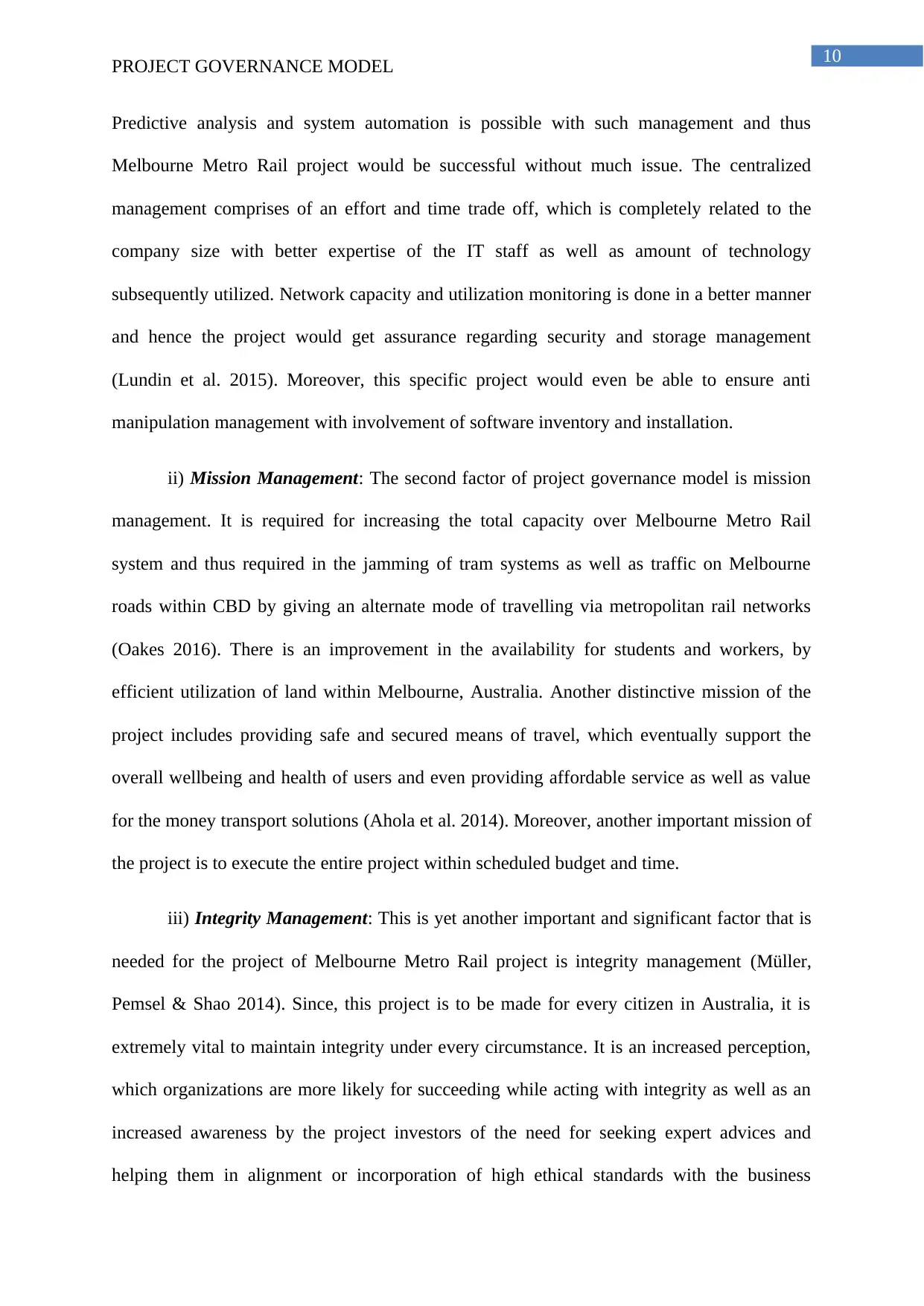
10
PROJECT GOVERNANCE MODEL
Predictive analysis and system automation is possible with such management and thus
Melbourne Metro Rail project would be successful without much issue. The centralized
management comprises of an effort and time trade off, which is completely related to the
company size with better expertise of the IT staff as well as amount of technology
subsequently utilized. Network capacity and utilization monitoring is done in a better manner
and hence the project would get assurance regarding security and storage management
(Lundin et al. 2015). Moreover, this specific project would even be able to ensure anti
manipulation management with involvement of software inventory and installation.
ii) Mission Management: The second factor of project governance model is mission
management. It is required for increasing the total capacity over Melbourne Metro Rail
system and thus required in the jamming of tram systems as well as traffic on Melbourne
roads within CBD by giving an alternate mode of travelling via metropolitan rail networks
(Oakes 2016). There is an improvement in the availability for students and workers, by
efficient utilization of land within Melbourne, Australia. Another distinctive mission of the
project includes providing safe and secured means of travel, which eventually support the
overall wellbeing and health of users and even providing affordable service as well as value
for the money transport solutions (Ahola et al. 2014). Moreover, another important mission of
the project is to execute the entire project within scheduled budget and time.
iii) Integrity Management: This is yet another important and significant factor that is
needed for the project of Melbourne Metro Rail project is integrity management (Müller,
Pemsel & Shao 2014). Since, this project is to be made for every citizen in Australia, it is
extremely vital to maintain integrity under every circumstance. It is an increased perception,
which organizations are more likely for succeeding while acting with integrity as well as an
increased awareness by the project investors of the need for seeking expert advices and
helping them in alignment or incorporation of high ethical standards with the business
PROJECT GOVERNANCE MODEL
Predictive analysis and system automation is possible with such management and thus
Melbourne Metro Rail project would be successful without much issue. The centralized
management comprises of an effort and time trade off, which is completely related to the
company size with better expertise of the IT staff as well as amount of technology
subsequently utilized. Network capacity and utilization monitoring is done in a better manner
and hence the project would get assurance regarding security and storage management
(Lundin et al. 2015). Moreover, this specific project would even be able to ensure anti
manipulation management with involvement of software inventory and installation.
ii) Mission Management: The second factor of project governance model is mission
management. It is required for increasing the total capacity over Melbourne Metro Rail
system and thus required in the jamming of tram systems as well as traffic on Melbourne
roads within CBD by giving an alternate mode of travelling via metropolitan rail networks
(Oakes 2016). There is an improvement in the availability for students and workers, by
efficient utilization of land within Melbourne, Australia. Another distinctive mission of the
project includes providing safe and secured means of travel, which eventually support the
overall wellbeing and health of users and even providing affordable service as well as value
for the money transport solutions (Ahola et al. 2014). Moreover, another important mission of
the project is to execute the entire project within scheduled budget and time.
iii) Integrity Management: This is yet another important and significant factor that is
needed for the project of Melbourne Metro Rail project is integrity management (Müller,
Pemsel & Shao 2014). Since, this project is to be made for every citizen in Australia, it is
extremely vital to maintain integrity under every circumstance. It is an increased perception,
which organizations are more likely for succeeding while acting with integrity as well as an
increased awareness by the project investors of the need for seeking expert advices and
helping them in alignment or incorporation of high ethical standards with the business
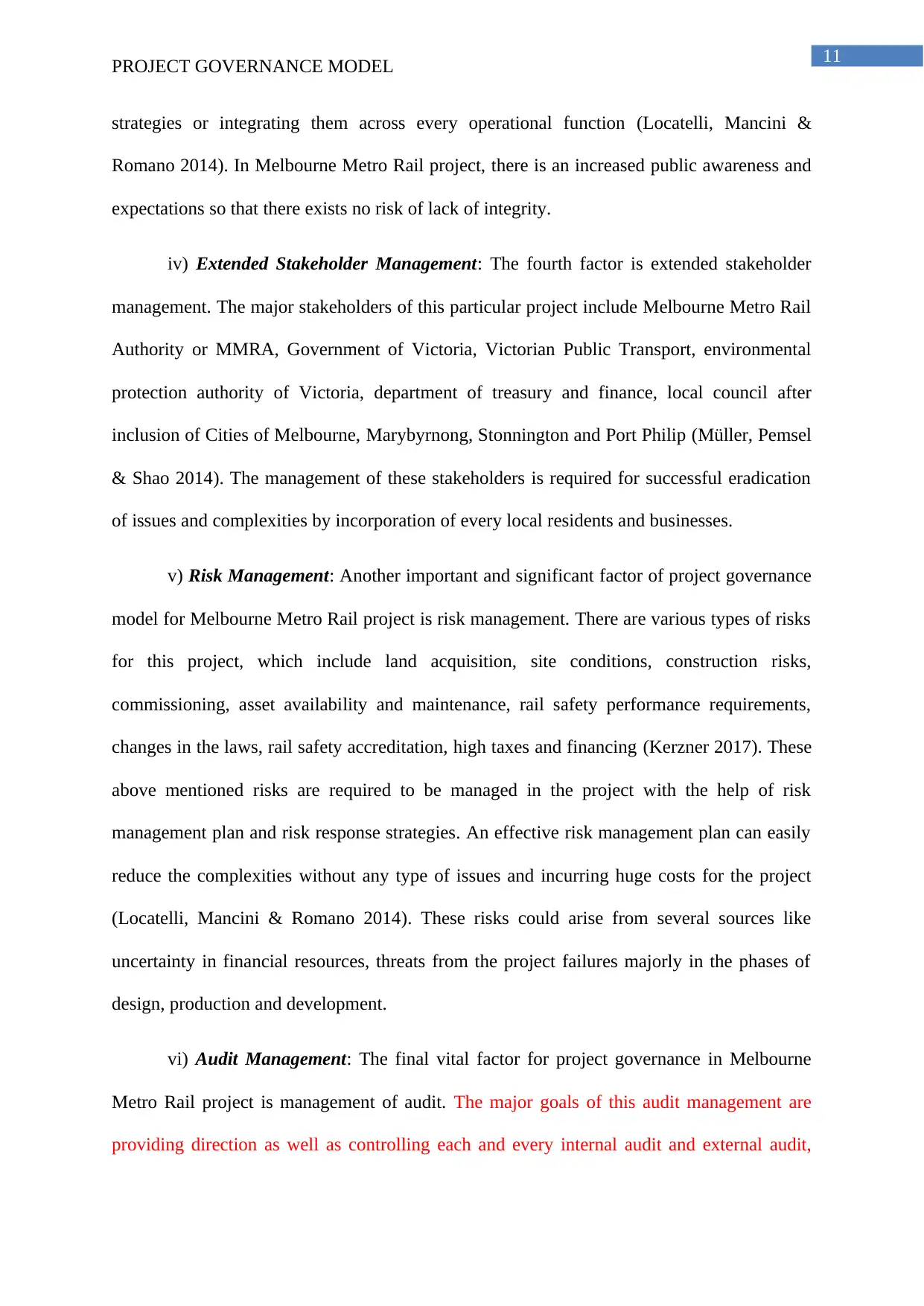
11
PROJECT GOVERNANCE MODEL
strategies or integrating them across every operational function (Locatelli, Mancini &
Romano 2014). In Melbourne Metro Rail project, there is an increased public awareness and
expectations so that there exists no risk of lack of integrity.
iv) Extended Stakeholder Management: The fourth factor is extended stakeholder
management. The major stakeholders of this particular project include Melbourne Metro Rail
Authority or MMRA, Government of Victoria, Victorian Public Transport, environmental
protection authority of Victoria, department of treasury and finance, local council after
inclusion of Cities of Melbourne, Marybyrnong, Stonnington and Port Philip (Müller, Pemsel
& Shao 2014). The management of these stakeholders is required for successful eradication
of issues and complexities by incorporation of every local residents and businesses.
v) Risk Management: Another important and significant factor of project governance
model for Melbourne Metro Rail project is risk management. There are various types of risks
for this project, which include land acquisition, site conditions, construction risks,
commissioning, asset availability and maintenance, rail safety performance requirements,
changes in the laws, rail safety accreditation, high taxes and financing (Kerzner 2017). These
above mentioned risks are required to be managed in the project with the help of risk
management plan and risk response strategies. An effective risk management plan can easily
reduce the complexities without any type of issues and incurring huge costs for the project
(Locatelli, Mancini & Romano 2014). These risks could arise from several sources like
uncertainty in financial resources, threats from the project failures majorly in the phases of
design, production and development.
vi) Audit Management: The final vital factor for project governance in Melbourne
Metro Rail project is management of audit. The major goals of this audit management are
providing direction as well as controlling each and every internal audit and external audit,
PROJECT GOVERNANCE MODEL
strategies or integrating them across every operational function (Locatelli, Mancini &
Romano 2014). In Melbourne Metro Rail project, there is an increased public awareness and
expectations so that there exists no risk of lack of integrity.
iv) Extended Stakeholder Management: The fourth factor is extended stakeholder
management. The major stakeholders of this particular project include Melbourne Metro Rail
Authority or MMRA, Government of Victoria, Victorian Public Transport, environmental
protection authority of Victoria, department of treasury and finance, local council after
inclusion of Cities of Melbourne, Marybyrnong, Stonnington and Port Philip (Müller, Pemsel
& Shao 2014). The management of these stakeholders is required for successful eradication
of issues and complexities by incorporation of every local residents and businesses.
v) Risk Management: Another important and significant factor of project governance
model for Melbourne Metro Rail project is risk management. There are various types of risks
for this project, which include land acquisition, site conditions, construction risks,
commissioning, asset availability and maintenance, rail safety performance requirements,
changes in the laws, rail safety accreditation, high taxes and financing (Kerzner 2017). These
above mentioned risks are required to be managed in the project with the help of risk
management plan and risk response strategies. An effective risk management plan can easily
reduce the complexities without any type of issues and incurring huge costs for the project
(Locatelli, Mancini & Romano 2014). These risks could arise from several sources like
uncertainty in financial resources, threats from the project failures majorly in the phases of
design, production and development.
vi) Audit Management: The final vital factor for project governance in Melbourne
Metro Rail project is management of audit. The major goals of this audit management are
providing direction as well as controlling each and every internal audit and external audit,
⊘ This is a preview!⊘
Do you want full access?
Subscribe today to unlock all pages.

Trusted by 1+ million students worldwide
1 out of 17
Related Documents
Your All-in-One AI-Powered Toolkit for Academic Success.
+13062052269
info@desklib.com
Available 24*7 on WhatsApp / Email
![[object Object]](/_next/static/media/star-bottom.7253800d.svg)
Unlock your academic potential
Copyright © 2020–2025 A2Z Services. All Rights Reserved. Developed and managed by ZUCOL.




